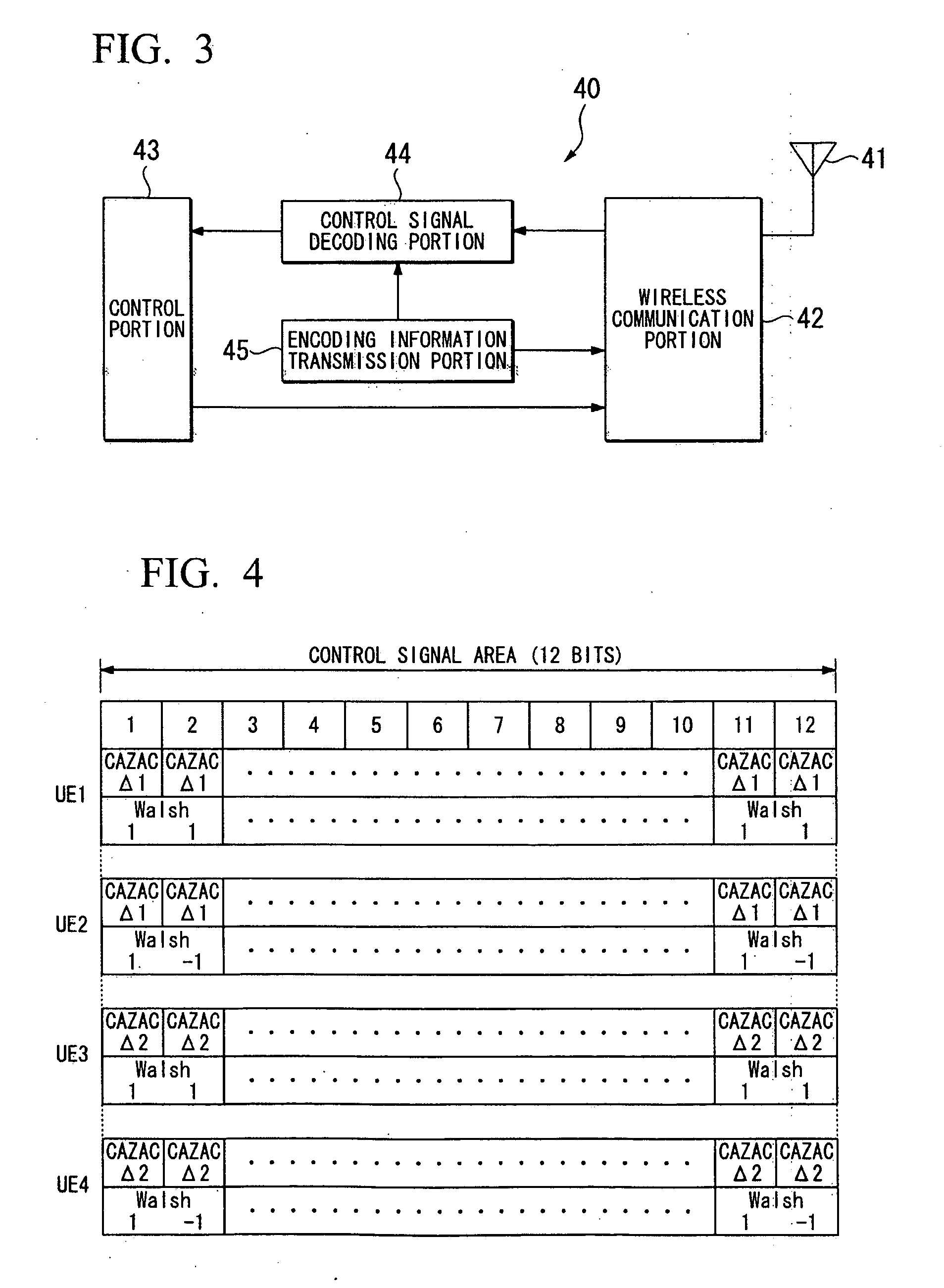Wireless Terminal Apparatus and Wireless Base Station Apparatus
a technology of wireless base station and terminal station, which is applied in the direction of multiplex communication, wireless commuication services, orthogonal multiplex, etc., can solve the problem of small number of terminal stations to which the code can be assigned
- Summary
- Abstract
- Description
- Claims
- Application Information
AI Technical Summary
Benefits of technology
Problems solved by technology
Method used
Image
Examples
example 1
[0050]FIG. 4 is a drawing for explaining Example 1 in which the first code and the second code of this example are used. In the Example 1, a pair of Walsh codes of two dimensions “(1,1) and (1,−1)” are used. In FIG. 4, a control signal area has a 12 bit length, and the encoding operation is conducted on data stored in this 12 bit area. In an example shown in FIG. 4, each of four terminal stations 1 (“UE1”, “UE2”, “UE3” and “UE4”) transmits a control signal of an uplink to the base station 40 which is a single base station.
[0051]As shown in FIG. 4, both “UE1” and “UE2” conducts an encoding operation on the control information by using CAZAC codes obtained by a phase-shifting of amount of Δ1. In addition, “UE1” conducts the encoding operation on the control information by using Walsh code of (1, 1), and “UE2” conducts the encoding operation on the control information by using Walsh code of (1, −1). In accordance with such a manner, even when both of CAZAC codes have the same amount of...
example 2
[0054]FIG. 5 is a drawing for explaining Example 2 in which a first code and a second code are used. In the Example 2, Walsh codes of four dimensions “(1, 1, 1, 1), (1, −1, 1, −1), (1, 1, −1, −1), (1, −1, −1, 1)” are used. In an example shown in FIG. 5, in the similar manner as shown in FIG. 4, an encoding operation is conducted on a control signal area of 12 bits. In the similar manner as shown in FIG. 4, each of four terminal stations 1 (“UE1”, “UE2”, “UE3” and “UE4”) transmits a control signal of an uplink to the base station 40 which is a single base station.
[0055]As shown in FIG. 5, by using the CZAC codes obtained by phase-shifting with a phase-shifting amount of Δ1, all of “UE1”, “UE2”, “UE3” and “UE4” conducts an encryption operation on the control information. It should be noted that each of these terminal stations, by using respectively different Walsh code, conducts the encryption operation on the control information. “UE1” uses Walsh code of (1, 1, 1, 1), “UE2” uses Wals...
example 3
[0057]FIG. 6 is a drawing for explaining Example 3 in which a first code and a second code are used. In the Example 3, in a similar manner as explained in Example 1, a pair of Walsh codes of two dimensions “(1,1) and (1,−1)” are used. In addition, in a similar manner as explained in Example 1, the encoding operation is conducted on data stored in a control signal area which has a 12 bit length. It should be noted that the encoding operation on Walsh codes is conducted only on a predetermined bit position included in the control signal area of 12 bits. In other words, the encoding operation on Walsh codes is not necessary that is conducted on all bit positions included in the control signal area. In accordance with Example 3, similarly as described in Example 1, it is possible to assign a pair of terminal stations to a single phase-shifting amount applied to the CAZAC code. Therefore, compared to a prior art in which CAZAC code with an unique phase-shifting amount is assigned to each...
PUM
 Login to View More
Login to View More Abstract
Description
Claims
Application Information
 Login to View More
Login to View More - R&D
- Intellectual Property
- Life Sciences
- Materials
- Tech Scout
- Unparalleled Data Quality
- Higher Quality Content
- 60% Fewer Hallucinations
Browse by: Latest US Patents, China's latest patents, Technical Efficacy Thesaurus, Application Domain, Technology Topic, Popular Technical Reports.
© 2025 PatSnap. All rights reserved.Legal|Privacy policy|Modern Slavery Act Transparency Statement|Sitemap|About US| Contact US: help@patsnap.com



